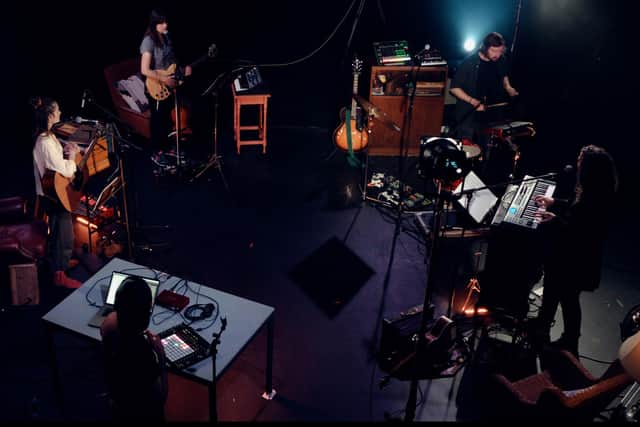A Giant On The Bridge: The gig theatre show using music to explore life after prison
You are driving down the street, joining in with a song on the radio at the top of your voice. We have all done it. Jo Mango was the same. But this time there was a surprise for the Glasgow singer-songwriter.
“I was singing away to some stupid pop hit on Radio 1,” she says. “Then in the other direction, this woman came in her car singing along to the same song. We both clocked each other singing. There was this weird moment: she was a complete stranger, but we were connected by the act of singing the same thing.”
Advertisement
Hide AdThat moment of connection is what she loves about music. Whatever our differences, we find common purpose when we share a song. That is why, when she came to creating a show about people leaving prison, Mango decided the form would have to be gig theatre. Only music could reconcile prisoners, victims, prosecutors and friends in a single performance.
“Music helps with dialogue,” she says. “If you have a political debate, people are shouting at each other, you’ve got oppositional stances and it becomes a flashpoint. But if you get people along to a gig, it’s a different way of feeling the emotions of someone you might never have wanted to engage with.”
A Giant On The Bridge has been a long time coming. A few years ago, Mango was taken on by arts charity Vox Liminis, in partnership with the University of Glasgow, to be part of Distant Voices, a project that explores crime, punishment and reintegration through songwriting. “You can ask someone questions in an interview and get a certain type of answer,” says Mango. “But if I were to sit down with you and say, ‘Let’s write a song about this,’ we’d get a whole different kind of perspective.”
She and her fellow musicians, including C Duncan, Emma Pollock, Chris Drever, Rachel Sermanni and Admiral Fallow, wrote more than 200 songs with prisoners, governors, social workers and victims of crime. They released an album, Not Known At This Address (2018), followed by two EPs, Oblivion And Beyond (2019) and Looking At Colours Again (2021).
“More often than not, the songs were bridges,” she says. “People are aware that if they’re going to get out of prison, they need to fix these relationships that are key to them. They would write a song to their daughter to say, ‘I’m sorry I’ve been away,’ or for their partner to say, ‘Keep believing in me.’ They were bridge-building exercises to maintain the links that were going to be important.”


In an attempt to distil what they had learned, Mango began putting the songs together to tell a story, then brought in Liam Hurley as director, dramaturg and collaborative writer to fashion the material into a piece of theatre. After giving it a two-day preview at Edinburgh’s Traverse, they plan to bring A Giant On The Bridge back for an extended life.
Advertisement
Hide Ad“A lot of people have radical and positive things to say about the criminal justice system, but for me what’s universal is the story of homecoming,” says Hurley. “We’re telling a story about an individual who is leaving prison and preparing to make that transition home again. It’s about relationships with family, belonging and home.”
Mango adds: “We don’t have words for so much of the experience of prison because we don’t talk about it. We’ve got so many words for being drunk, because that’s such a common experience, but there are some experiences that don’t have any words, so what can music do to help us express those things?”
Advertisement
Hide AdThe questions the show raises are of no minor concern. Every year, 10,000 people in Scotland return home from prison. They and those they have affected have a lot of readjusting to do. “The show asks big questions about why we do criminal justice the way we do it and is it the best thing we can think of?” says Mango. “We’re not making a statement, but the characters demonstrate the difficulties inherent in the system.”
Hurley agrees: “The political act is opening up a conversation and humanising people who have been othered, rather than pushing one perspective.”
To help them shape the material, they took the songs to a group of restorative justice experts in Northern Ireland whose job is to get people to talk to each other. “We asked: ‘If these songs were people sitting in a room together, how would you facilitate that conversation?’” says Mango. “They loved hearing the songs and would say, ‘Oh, I can totally imagine that young offender,’ or they’d pick up on one line and say, ‘That shows there’s hope for change.’ I found it so hopeful because they said, ‘Yeah, those songs could definitely talk to each other and here’s how we would do it.’”
On stage, the songwriter is joined by Louis Abbott, Jill O’Sullivan, Raveloe and Solareye, playing music as varied as the experiences they sing about. The score embraces hip hop, indie, electronic, folk and rock. “We’re expressing the character of loads of different people and it would seem wrong if it were all mashed into the same genre,” says Mango. “The music echoes the idea of dialogue: how do you get these different voices to talk to each other. It’s a question that we as genre-hopping musicians ask ourselves all the time.”
A Giant On The Bridge, Traverse Theatre, Edinburgh, 8-9 March, www.traverse.co.uk